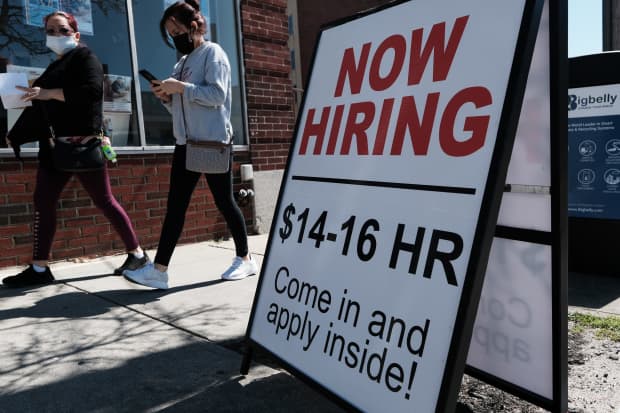This post was originally published on this site
The numbers: The U.S. created a robust 850,000 new jobs in June as the economy perked up and companies rushed to add more workers, but at the current pace of hiring it’s likely to take more than a year before employment returns to pre-Covid levels.
The increase in hiring last month — the biggest in 10 months — easily exceeded Wall Street’s estimate. Economists polled by The Wall Street Journal had forecast 706,000 new jobs.
Most of the new jobs were clustered in service-oriented positions at restaurants, hotels, retailers and the like.
Government payrolls also rose by 188,000, but that was largely the result of pandemic-related effects on education and probably should be discounted. If those jobs are set aside, the job gains in June were a bit less impressive.
The unemployment rate, meanwhile, rose slightly to 5.9% from 5.8%. The official rate likely underestimates true unemployment by two to three percentage points, economists say.
The size of the labor force, in a disappointing sign, only rose a little bit. The share of working-age people in the labor force was unchanged at 61.6%.

The U.S. gained 850,000 jobs in June in a show of strength for the economy.
The paradox of what’s turned into a robust economic recovery is that unemployment is still quite high despite a record number of job openings.
Many Americans are reluctant to return to work. Some are still fearful of the virus. Others have to care for young or old family members. And generous unemployment benefits allow people to be more choosy about the jobs they take.
Some 26 states will stop giving out extra federal benefits of up to $300 a week by early July in an effort to nudge people to return to work. Businesses have complained that high jobless benefits are deterring people from accepting jobs, but there’s not a lot of evidence so far to back up their argument.
People are also quitting at record levels, in most cases to take a better-paying jobs. That’s pitting companies against each other for labor.
Still, the increase in private-sector hiring in June suggests companies are finding ways to attract or retain valued employees. Many have raised pay and benefits or offered other incentives such as bonuses.
The June jobs figures gave a small lift to the stock market. Equities opened higher.
Big picture: The U.S. has plenty of job openings and plenty of unemployed people to fill them. Job openings recently hit a record 9.3 million and by some measures is roughly equal to the number of jobless Americans.
What’s partly holding back hiring, economists say, are several factors. The biggest are lingering problems from the pandemic.
By the fall most of these problem should fade away as schools, day-care centers and nursing homes fully open, economists say. That will make it easier for care-givers — women in particular — to go back to work. So will fully operating public transportation systems.
Extra federal benefits will also end in all states in early September, potentially pushing more people back into the labor force.
As these issues clear up, the economy is expected to gain further strength and grow rapidly through the end of the year. Many companies are flush with record demand. They simply lack the manpower to provide all the services or make all the goods that they can sell.
Key details: Businesses in leisure and hospitality that suffered the worst in the early stages of the pandemic added the most new jobs last month. They hired 343,000 new workers in June, mostly at restaurants, hotels, arts, theater and entertainment.
Flush with stimulus money and buoyed by the rapid decline in the coronavirus, many Americans want to do all things they avoided during the pandemic: Dine out, go to the theater, take a vacation or fly to visit family.
Government employment posted the next largest gain.
Professional businesses also added 72,000 jobs and retailers hired 67,000 people.
The only industries to shed jobs was construction. Employment fell by 7,000
In June, the average wage rose 10 cents, or 0.3%, to $30.40 an hour. Wages have risen a larger than typical 3.6% over the past year.
Many companies say they are offering higher pay to attract workers, but the pandemic has skewed the government’s statistics and it’s still unclear how rapidly wages are going up.
Economists say it will be awhile until the wage numbers become reliable again and they can figure out what it really going on.
What they are saying? “Things are picking up. All that employer demand is turning into jobs and higher wages for many workers,” said Nick Bunker, economist research director at Indeed Hiring Lab.
Market reaction: The Dow Jones Industrial Average
DJIA,
and S&P 500
SPX,
increased slightly in Friday trades and were near or at record levels.
The yield on the 10-year Treasury note
TMUBMUSD10Y,
was little changed.

